As land prices soar in Goa, efforts are being made to retain heritage Portuguese architecture homes falling to the bulldozer

People never realise what they have until it is too late, goes the adage. Something like that is happening in Goa. Take Calangute, the popular beach destination in north Goa.
ADVERTISEMENT
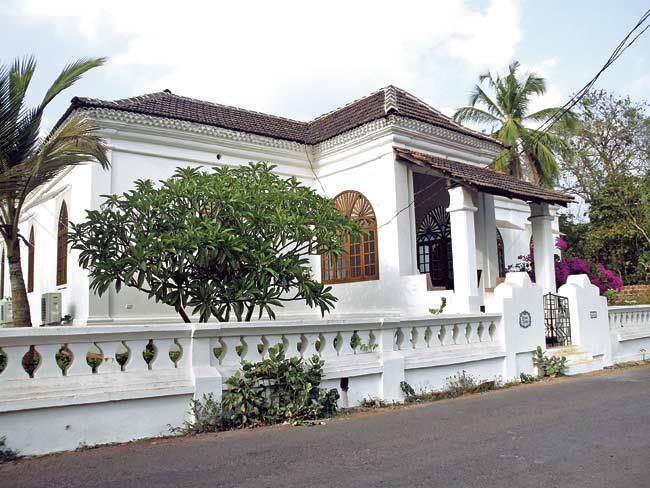
A typical Goan house
In the last three decades, as it shot up the tourism popularity charts, stately old houses were wiped off to build modern resorts, and Goan property owners sold off their land, mostly to outsiders, to make hay while the sun shone.
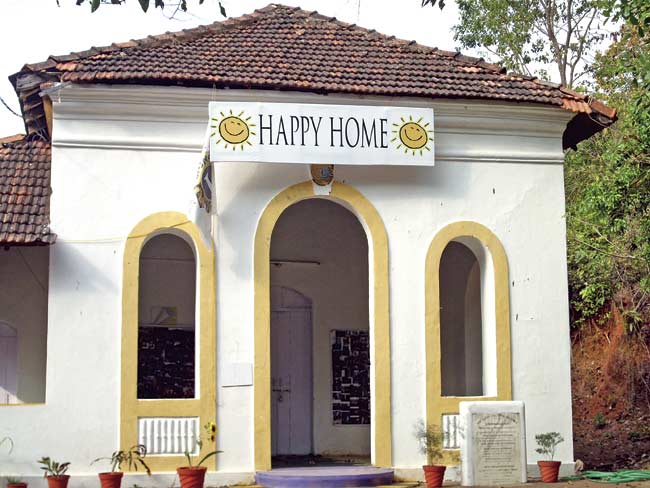
An old house now used as a yoga centre
Portugal Visit
And then last September, all the Calangute village Panchayat members visited Portugal, the former colonial ruler of Goa, and when they came back, they had one realisation: there was hardly any of that old Portuguese flavour left in Calangute.
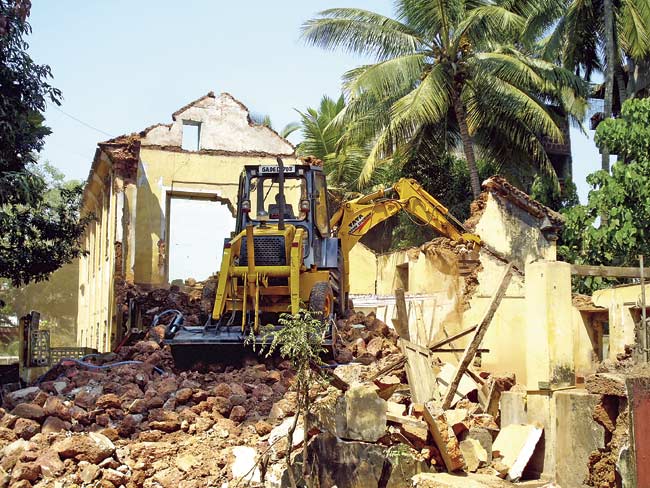
Yet another Goan house being bulldozed
So, the Panchayat members decided that buildings on the main road leading to the beach would be painted in a combination of yellow and white, as in some parts of Lisbon Portugal, and secondly, the Panchayat building, a modern, faceless concrete structure with a functional design, was renovated and its façade changed to resemble an old Goan house.
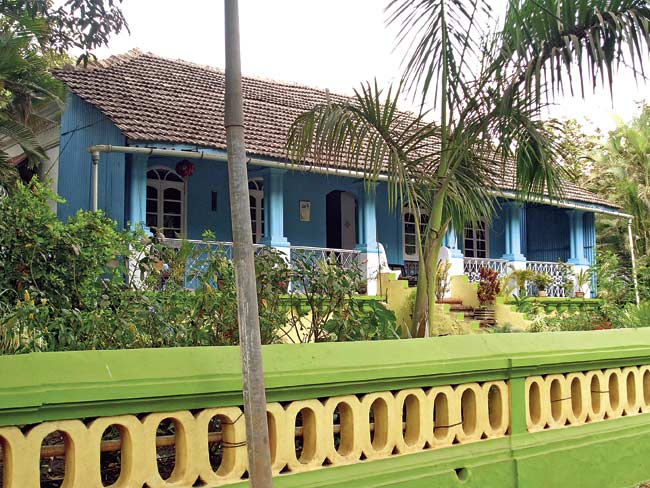
A brightly painted typical Goan house
In the months since, they managed to persuade only a couple of building owners to paint them yellow-white. The others have refused to do so, rendering the Panchayat helpless.
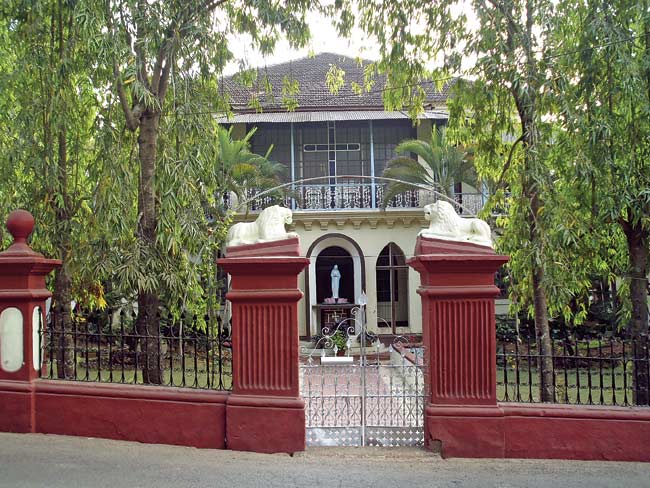
An old mansion now used as seminary
Even the two buildings which changed their colours are modern constructions. Which kind of made the whole exercise look futile, and Panchayat members now confess that they have all but abandoned the idea. The story is illustrative of the situation in Goa.
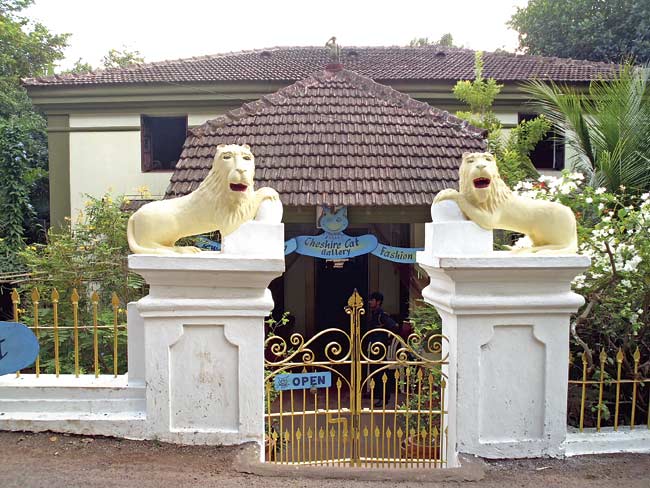
An old house purchased by foreigners is now used as a designer jewellery boutique
Goan or ‘Portuguese’ houses in Goa have become a big draw. Goans themselves, new settlers from other parts of India, and foreigners, too, with the last segment the most interested in buying ruined old houses and restoring them.
Price Question
Until about a decade or two ago, you could get a large Goan house with a garden-fruit orchard set in a couple of acres for Rs 10 to 20 lakh. Now the same will cost a few crores. Fancier aristocratic homes go for double-digit crores.
It is this revival of interest and demand, which has sparked off a new boom. According to experts, these old Goan houses from the Portuguese era (Goa was ‘liberated’ from Portuguese rule in 1961) are actually works of art. So now people buy them to add to their art collection, as an investment, or to experience the pleasure of living within a work of art, as in an installation.
Houses of Goa
Goan architect Gerard D’Cunha has been a pioneer in realising the value of old Goan homes. He was the first to start a museum dedicated to these homes. It is called Houses of Goa and is located in a quiet village near Panaji. It focuses on architectural aspects.
He says there are two aspects to the situation right now. “Old houses are disappearing in certain areas where the land rates are very high, as in Panaji. So the owners stand to make a lot more money by demolishing the house and constructing a new building. But in other areas where the land rates are still low, people are realising that it makes more sense to retain old houses, because today, a lot of rich people coming to Goa are willing to pay a lot of money for an old house,” he explains.
“Many old houses are being bought and restored and some are being rehabilitated as boutique hotels,” he says. There are some unique aspects about Goan homes which make them quite special, largely because the Portuguese ruled Goa for 450 years, starting in 1510, much before the rise of the Mughal Empire.
“We in Goa, have a strange but novel history. We are part of the first sustained encounter between the East and the West. When the Portuguese colonised Goa, they brought in their own architectural designs and lifestyle to influence the already strong culture and architecture that prevailed here. As a result of the amalgamation, an entirely new thing emerged. What you see in Goan houses, you don’t see in Portugal or elsewhere in the world,” Gerard explains.
“It is our own Goan style. Goan Catholics were people who were converted and who were looking for a new identity. Thus they embarked on the experiment in architecture, to produce something unique and unseen anywhere in the world,” he adds.
History Lesson
One of the best chroniclers of Goan homes has been Heta Pandit, originally a Parsi from Gujarat, who conducts heritage walks in Goa and has authored a number of books on Goan homes.
According to her, the year 1750 was a turning point in Goa’s political and social history, and was also responsible for the exuberance and ostentation in architectural wealth in the houses of Goa built subsequently. So what happened in the middle of the 18th century?
“The gold rush in South America had begun a few years into the reign of King João V and following this wealth came into Goan hands. The proclamation by the powerful Marquis de Pombal, Prime Minister to the King which declared all colonial subjects to be Portuguese further emboldened Goans. (Unlike British India, Goa was considered a province of Portugal and had representation in the Portuguese Parliament.)
They began to express themselves (and their Goan identity) through music, dance, sculpture, painting, food and folklore. It was around this time that Goans first began to use their homes as vehicles of this expression. They also began to use their homes to display personal wealth, unthinkable before the arrival of the Europeans,” she says.
Art in Goa often manifests itself in the form of a functional object or dwelling; art as an article of acquisition is completely alien to the Goan psyche, according to Heta Pandit. "The houses built between the middle of the 18th century and the early part of the 20th century display a unique combination of artistry and architecture rarely seen elsewhere," she says.
Conservation Zones
There are now voices constantly raised for preserving and conserving them, though many are still being knocked down. Goa too, has started creating conservation zones to preserve these houses. There are two in Panaji, the capital city, in Fontainhas and Campal, which have been designated as ‘Heritage Zones’ because most of the houses are still the old ones.
The Goa government had also started a ‘Heritage Homes’ scheme through the Tourism Department allowing a substantial subsidy to the owners of these old houses to maintain them and to use the houses as ‘home-stays’ for tourists desiring to stay in a heritage house.
In fact, the Heritage Houses Movement also led to a greater awareness about the changing Goan landscape with some villages like Calangute already turned into concrete jungles, and also the degradation of the natural environment, with huge new residential complexes being built to cater to the needs of tourists and others wanting to settle down in paradisiacal Goa.
In the last decade, many NGOs and movements have sprung up to save what is left. Prominent among them were the Goa Bachao Abhiyan (Save Goa Movement), and the Village Groups of Goa, with many other smaller NGOs and citizen groups, all of which have been campaigning to “save Goan identity” which means its houses, the serenity of villages and natural environment.
All these movements have now coalesced into a demand for a ‘special status’ to Goa, one of the main points in the election manifestos of the political parties in the current Lok Sabha elections. As the Congress manifesto puts it: “Goa being a small and beautiful state, there is a mad rush, both nationally and internationally, for people to own a piece of this beautiful land.
Both national and international land sharks and mafias are involved in a big way in depleting the scarce land. Hence, people feel their unique identity must be retained for posterity at least by putting an end to huge transfer of land to non-Goans.”
Changing Times
A few of the grand old houses are now museums showcasing the old Goan lifestyle, crafts, cuisine, artifacts etc. One of the biggest is the sprawling, theme park-style ancestral Goa at Loutoulim in south Goa which has some remarkably well-preserved Goan houses with period furniture and decorations. One house is entirely devoted to a collection of crosses.
The biggest house in Goa is the Menezes Braganza house in Chandor village, close to Margao city. Said to be more than 500 years old, the sprawling property was built in stages, first by the Hindu ancestors of the present owners, and then by their Catholic descendants, and has huge ballrooms and saloons with antique furniture and art, and is now open as a museum.
Another noteworthy museum is Calizz (which means heart in Konkani) at Candolim. Winner of the National Tourism Award 2007-08 for ‘The Most Innovative / Unique Tourism Project of India’ awarded by the Ministry of Tourism, Government of India, it has a number of impressively beautiful houses which once belonged to an aristocratic family. Inside are displayed all kinds of odds and ends which made up the Goan lifestyle.
Present owner Nandan Kudchadkar, who also owns a popular nightclub, in an emotional vein, says his father purchased the property and collected the articles displayed inside over his lifetime, and it is as a tribute of love to his late father that he will make sure that the “heart of Goa”, as he calls the museum, will be preserved.
Lost Identity
Joao Felipe Perreira is the convenor of the Village Groups of Goa, which has attempted to bring the many village-level groups fighting to preserve Goan identity together. He says, “We Goans are losing our identity.
Every village is being demographically changed because of brain drain. Our youth are going to foreign countries and then there is nobody to look after the property, because of which the properties get ruined and are also encroached on by others. “The second major reason for why these houses are going is the greed for money.
Land prices have gone up manifold because of the black money which is being invested in Goa by people from Mumbai and Delhi. So Goans are tempted to sell their properties which are then developed into new residential complexes. Also, there are many family disputes, with some family members fighting to sell their properties because the property prices are high,” says Joao.
“The other reason why people sell their properties is because maintaining these old houses has become a big problem. Earlier, labour was cheap. Now even if you can afford them, you won’t find the right masons or carpenters who know how to maintain Goan houses,” he says.
Over time, perhaps only the stately visages of the white churches which dot the Goan landscape would be left. Jose Lourenco, the author of ‘Churches of Goa’, says, “Fortunately the old churches, both parish as well as those in Old Goa, are taken good care of. Villagers are aware of the antiquity of their churches and contribute towards their upkeep.
Even chapels and roadside crosses are mostly well maintained. Parishioners are alert enough to question any plans to modify their old churches or to demolish them. It has been a tradition in the last centuries during Portuguese rule to demolish old chapels and churches to replace them with new ones, But in recent decades new churches, if required to accommodate growing parishes, are being built alongside the old ones.”
It is evident that this is an unequal battle between the old and the new. Hopefully though, a few of these lovely houses will stand the test of time, to remind generations of ‘Golden Goa’, as it was once known.
 Subscribe today by clicking the link and stay updated with the latest news!" Click here!
Subscribe today by clicking the link and stay updated with the latest news!" Click here!






